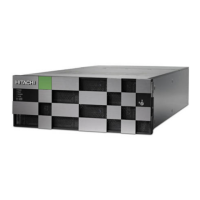Description Receptacle (male end) Input rating Reference standards
AS-3112
200V-240V 6 AS C112
Power cable usage guidelines
Hitachi storage systems are intended for rack installation and ship with power
cords. Installation and service requirements may require additional cords and
cables to be ordered. The type of power cable required by a given installation
is determined primarily by the:
• Type of AC line feed provided by the facility.
• Type of AC source (wall outlet or modular and monitored PDU) to be used.
• Serviceability of components to be connected.
Storage systems require a country-specific power cable for direct connection
to a facility AC feed.
Storage systems are designed to allow replacement of hot-pluggable
components without removing the chassis from the rack. As a result, power
cables can be short because cable movement is of minimal consideration.
Three-phase power considerations for racks
Increasing power requirements for racks are making the use of three-phase
power at the rack level compelling.
• With single-phase power, at any given time the voltage across the hot and
neutral conductors can be anywhere between its peak (maximum) and
zero. Electrical conductors must be large to meet high amperage
requirements.
• Three-phase power uses three cycles that are 120 degrees out of phase,
which never allows the voltage to drop to zero. The more consistent
voltage derived from the three hot conductors results in smoother current
flow and allows small-gauge conductors to be used to distribute the same
amount of AC power. As a result, the load balancing and increased power
100 Data and power cables
Hitachi Virtual Storage Platform G400, G600 Hardware Reference Guide

